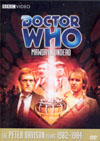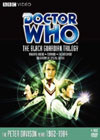DVD Extras include:
The Doctor's plot strand with Nyssa and Tegan in the first episode is not grand or riveting, but will do. Their first scene spends much time (unnecessarily?) explaining events of the previous story "Snakedance". I suppose this is alright if one is watching the entire season in order, but for those watching this story on its own, or as the first in a trilogy box set, it's all a lengthy, confusing, meaningless bit, as well as a spoiler for something they may not have seen yet. And when continuity is too tight like this, it neglects to leave space in between televised stories for other adventures that exist only in the viewers' imaginations. Sad. The original introduction to the TARDIS was not great for this story, throwing in a single shot of the police box materializing in an unfamiliar set, and then cutting away and back before showing our trio coming out of it, but at least the prior scene in the console room delivered a proper set-up for the effect. This sequence was also the most obvious candidate for CGI improvement in the entire story, featuring a decidedly flat painting of a spaceship zooming towards the TARDIS. Nicely the CGI team added entirely new shots to the sequence, making the TARDIS a little easier to understand for first time viewers. And since the TARDIS is used so much in every episode of this adventure, it is doubtful that any viewer will come to the end of it not understanding its basic properties. Using some trademark humour and perhaps a bit too much hasty running around, the Doctor, Nyssa, and Tegan embark on a bit of exploration centering on this very bizarre and seemingly empty spaceship. While these scenes are okay and do intrigue, other stories have provided stronger lines of exploration, and it is difficult to tell where the example of it in this story is going. In many respects, these portions of the story are being overshadowed by Turlough's plot. He really owns the first episode, and it is all about him getting the ball rolling for the rest of the story.
First ImpressionsHaving only seen the first three Key to Time stories before getting into season 18 and beyond, I was over the moon to finally see the Black Guardian appear in a Doctor Who story. This was the villain I'd been waiting for. The much-criticized bird on the head of his costume didn't bother me at all, as it provided a logical link to much of the dialogue in "The Stones of Blood" (story no. 100), and anyway, the wonderful Valentine Dyall gives such a strong and powerful performance as the Guardian that it was a long time before I even noticed it. Mark Strickson throws a lot into his performance as Turlough, and together the two make a uniquely sinister and frightening pair.Episode one ends without really explaining Nicholas Courtney's character. Was this the same Brigadier from the Jon Pertwee era that I'd read about in novelizations of stories like "Inferno" (story no. 54)? His stated belief that solid objects can't dematerialize seemed to indicate that he was not. But in the end, this is a fair quandary to leave us in for a week, because episode two becomes a really strong and enjoyable exploration of the Brigadier, his life, and a peculiar time paradox as well. The reality that this is our good old Brigadier is definitively answered by yet another successful JNT era flashback sequence, and quite a satisfying one to boot. We get more very successful editing for the 80's during this episode, as cuts between our two major plot strands also perfectly double as going into and out of the Brigadier's lost memories, with many helpful and logical links in the dialogue. One of the most beautifully written continuing juxtapositions in all of Doctor Who! Successful sections like this help us excuse many other sequences where scenes are too short and cuts between separate parts of the story are too frequent, because at least we have by then a better sense of who the characters are and what they want to achieve. And it's only near the end of episode two, when David Collings' newly introduced character finally reveals his name to the audience, that one can begin to make sense of the story's bizarre title. A lot is required of Collings in order to make his character work within the story and create the right amount of uncertainty in our protagonists, and he seems to do a wonderful job of getting everything just right, elevating suspense, and being appropriately weird and sympathetic all at the same time. Nice.
The backstory for this adventure delves into Timelord mythology, and this is critical for understanding the unfolding plot and the danger. I think it is good that this story follows "Arc of Infinity" (story no. 124) in the season, because images from that story can come to mind and help make better sense of what gets talked about here. Nice. It is also worth noting once more, that even though the Timelord character of Borusa has appeared in four separate stories and been played by a different actor each time, and two of those stories are from this very season, actor Angus MacKay who was the original Borusa in "The Deadly Assassin" (story no. 88) features here in this story as the school's headmaster. You'd think they would have preferred to cast him as Borusa instead, but I guess it had already been established that Borusa had regenerated into another actor's form several years prior. Still, it would have been a great precedent to set to show a Timelord regenerating back into one of his older forms, allowing previous actors to have another go in their roles. Paddy Kingsland returns to create the music for this story, and provides it with an enjoyable, effective, and solid backing. While several of the most major heavy themes are very similar, simple, and repeat maybe just a bit too often, these are interspersed with some lighter, fun cues that give the score more variety and a good emotional range. The theme for the Brigadier / school is particularly enjoyable, while the cue for the memory flashback sequence cleverly plays off of the Doctor Who theme itself and is recognizably unique within the score, instantly evoking nostalgia even for those of us who hadn't yet seen any of the stories featured in the sequence. Transmat is back for this adventure, now employing nifty looking capsules achieved with satisfying dissolve effects and appropriate sound. This is a uniquely Whovian element of the story, featuring prominently as it should. The capsule interior is a bit jarring, and could have used a proper introductory scene, with someone commenting on its design. Having an interior is of course a good way to avoid bringing David Collings and his costume & make-up challenges onto location, as we only see him in the capsule and in the TARDIS during his brief time on Earth. There still seems to be a hole in the plot logic concerning the capsules though. If Mawdryn originally brings the capsule down to Earth in 1977, and almost immediately abandons it to fly off in the TARDIS, how and why is the capsule camouflaged when Turlough discovers it in 1983? How and why did controls for the capsule end up inside the local architecture? This seems to remain a completely unanswered hole in the logic of the story, possibly leftover from earlier drafts that shaped the entire plot in a different way. Too bad this bit didn't get addressed. Perhaps the Black Guardian got some poor unsuspecting soul to do a few things for him in the intervening six years to help set the trap.... This story is perhaps also unique for this period of Doctor Who in having almost no violence anywhere in it, particularly during the conclusion. There is still a lot of tension built up towards the climax, and a lot of that is due to Valentine Dyall's insistence that things are drawing to a critical point, a lot is at stake, and things may yet go a number of different ways. The Doctor's character is put in a unique position at the end, and he has to make a difficult decision. Peter Davison plays the part very well during this sequence. However, it sadly isn't the Doctor's decision that solves today's crisis. It's more of pure chance, acting through the Brigadier, which is a bit disappointing in terms of the Doctor's heroics, but has a satisfying energy to it. After all, the Brigadier deserves his moments too, once in a while. Considering how hard the Black Guardian is working on metaphysical levels to bring about this trap, there must be some equal and opposite force countering him to bring this result about. Not too far-fetched, when you know how this trilogy ends....
International Titles:Magyar: "Az élőhalott Mawdryn"Français: (Mawdryn le mort vivant) Русский: "Мертвец Модрин" This story is available on DVD as the first adventure of the Black Guardian Trilogy. Click on the Amazon symbol for the location nearest you for pricing and availability:
Comments on this article are welcome. You may contact the author from this page:
|









